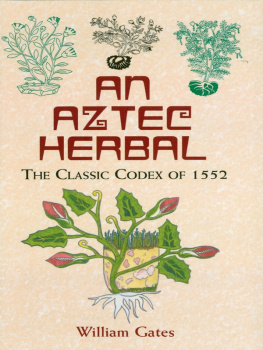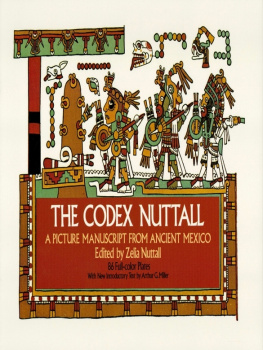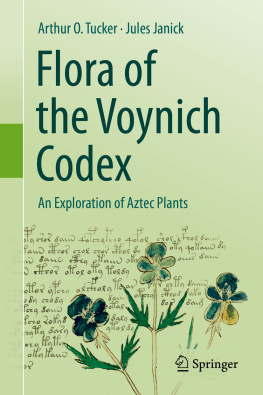An Aztec Herbal: The Classic Codex of 1552
Here you can read online An Aztec Herbal: The Classic Codex of 1552 full text of the book (entire story) in english for free. Download pdf and epub, get meaning, cover and reviews about this ebook. year: 2012, publisher: Courier Corporation, genre: Detective and thriller. Description of the work, (preface) as well as reviews are available. Best literature library LitArk.com created for fans of good reading and offers a wide selection of genres:
Romance novel
Science fiction
Adventure
Detective
Science
History
Home and family
Prose
Art
Politics
Computer
Non-fiction
Religion
Business
Children
Humor
Choose a favorite category and find really read worthwhile books. Enjoy immersion in the world of imagination, feel the emotions of the characters or learn something new for yourself, make an fascinating discovery.
- Book:An Aztec Herbal: The Classic Codex of 1552
- Author:
- Publisher:Courier Corporation
- Genre:
- Year:2012
- Rating:5 / 5
- Favourites:Add to favourites
- Your mark:
- 100
- 1
- 2
- 3
- 4
- 5
An Aztec Herbal: The Classic Codex of 1552: summary, description and annotation
We offer to read an annotation, description, summary or preface (depends on what the author of the book "An Aztec Herbal: The Classic Codex of 1552" wrote himself). If you haven't found the necessary information about the book — write in the comments, we will try to find it.
Unknown: author's other books
Who wrote An Aztec Herbal: The Classic Codex of 1552? Find out the surname, the name of the author of the book and a list of all author's works by series.
An Aztec Herbal: The Classic Codex of 1552 — read online for free the complete book (whole text) full work
Below is the text of the book, divided by pages. System saving the place of the last page read, allows you to conveniently read the book "An Aztec Herbal: The Classic Codex of 1552" online for free, without having to search again every time where you left off. Put a bookmark, and you can go to the page where you finished reading at any time.
Font size:
Interval:
Bookmark:
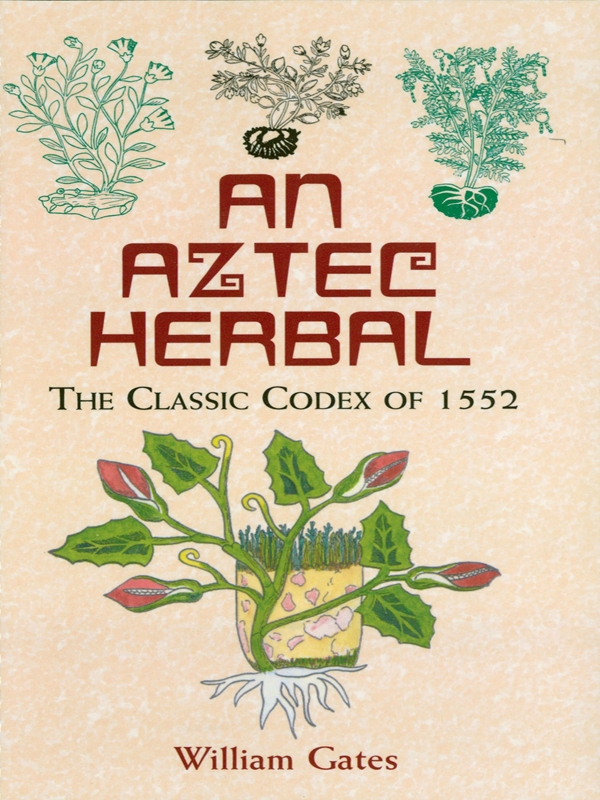
The original manuscript of our Herbal contains 63 folios, three of which being entirely blank have not been included in the pagination. The arrangement of the text is in the usual form, de capite ad calcem , in thirteen chapters, with remedies for 101 ailments, usually one only to a page. There are 185 pictures of plants, and a number of others mentioned in the text, but not pictured. To avoid confusion, the pictures and text not always coinciding, the pictures are referred to by the pages on which they are found, always with an asterisk: as ezpatli , *p. 33, while all references to plants just mentioned in the text read, Malinalli , 3h, meaning section h of cap. 3; this also found on page 33, with nine other plants, though not pictured, nor is the Ezpatli above mentioned in the text below.
The Aztec names are hyphenated throughout, to show their etymological parts, with the meanings there involved; this is of the greatest importance for the reader to follow, and also because with the sharply integrated word formation of the often very long Aztec words, the whole meaning is dependent on such hyphenation. Thus since a- is the stem of atl , water, and aca- of acatl , cane, if we should write aca-mallo-tetl , a cane would be understood, whereas writing a-camallo-tetl , it means that the stone, or lapis , is held down, imprisoned in the water, of course by the plants shown grasping it in the picture. Hyphenating the words, and correctly, is a simple necessity.
In this situation, further burdened by the great inattention to the keys of pharmacology and the absolutely essential real knowledge of Aztec as the language, we have in our Introduction and the following Index sought just to do two things: invite further study by others on these lines, and at the same time tell the general reader, as our space permits, what we can of interest about the plants themselves as a part of the pre-conquest Mexican life. We have ourselves in the progress of preparing the work for publication, learned much from the plant skill shown by De la Cruz, and his informative colored pictures of the plants he so clearly knew.
In Parts One and Three hereof we have thus tried to open the door to interest and understanding; we hope our readers will give their proper heed to De la Cruz and Badiano, and see through them, and once more through El Proto-Mdico Francisco Hernndez, a great background of science.
Many of the plants are definitely botanically, with our known terms; the ancient names of many have been lost in use, and the plant knowledge of even the 16th century with them. Long and intensive studies, from such skilled botanists as Sess and Mocio, sent by Charles III to pick up and follow Hernndezs work, down to Ramirez, Herrera and Alcocer and all the very capable moderns, have had to report this fact constantly.
In the Aztec words the x is to be pronounced sh (as it was in 16th century Spanish); tz and tl are treated as single letters like our ch , not to be separated. The accent regularly falls on the next to the last syllable.
Aca-capac-quilitl, pleasing cane edible. Aganippea dentata, *p. 79.
Grows in the Canal de la Vega, near Mexico City. v. Sahagn, xi-7.8.20.
Acatl, cane. Arundo donax L. *p. 79.
There are various reedlike plants, including edible ones, growing in or by water. Note the identical root forms on all four plants on p. 79, and also the similarity of the reedlike stalks for this and the next number.
A-chilli, water chile. *p. 65.
While there is no actual identification of this with the Salvia chian from which was made the refreshing drink so universally had during Holy Week, yet our sources, taken in parallel, strongly suggest it. First, Sahagn, discussing the achilli at xi-7.5.86, speaks of this chian ; further, the Madrid Hernndez, i-270, speaks of the achilton , or small achilli , as having the synonym piltzin - tecouh-xochit /; and then, our present section of the Badiano prescribing a number of aromatics, gives us in succession wormwood, mountain chian , and a-chilli , and just below piltzin-tecouh-xochitl.
Acocotli, or Acoco-xihuitl, aesophagus or suction pipe ; cumin. Arracacia atropurpurea, *p. 94, 10a.
The acocotli was used for sucking up the gathered juice of the maguey for making pulque, and the cane-like divisions of the stalk are plainly shown in the illustration. Three illustrations of an acocotli plant are given at Hern. 31, none resembling this in any way.
Robelo quotes Molina as to the above use of the stalk, and then gives it as being cumin or Arracacia atropurpurea, followed here by the Ph. Mex. and then by Martnez, all giving it as stimulant and carminative, which the two paragraphs in Sahagn fairly support.
Acxoyatl, a balsam. Abies religiosa, *p. 95, 10b.
The picture at Hern. 348 quite agrees with the one here in showing it as being of the Pine family.
Ahquiztli. Save for the picture at *p. 74, and its association with the long list of plants prescribed for a fever, 9b, no guide at hand.
Ahuatl, oak. Quercus castanea L. Quercus insignis. 8-1.
The Latin word Quercus is quite regularly used in the text, instead of the Aztec.
We also have an Ahuat/-tepiton, small oak, at *p. 88, but not repeated in the text. At p. 211 Hernndez illustrates the Ahuaton or Quercus parva , with the synonym Tlal-capulin ; also Sahagn gives us these same synonyms, at xi-7.5.49; also the term ava-quavitl at xi-6.2.8; and at xi-6.2.8 ava-tetzmolli as the holm oak.
A-huehuetl, water-growing cypress. Cupressus Montezuma, or Taxodium mucronatum.
This also is only referred to by its Latin name, but its fame is such as to merit the following quotation from Standley:
The largest individual reported is the famous one of Tule, near Oaxaca; its height is 38.6 meters and the girth 51.8 meters; the greatest trunk diameter is 12 meters, and the spread of the branches 51.8 meters. The Cypress of Moctezuma at Chapultepec was a noted tree four centuries ago, and its actual age estimated at 700 years; others have attained much greater periods.
The tree has been long used for its acrid resin, curative of ulcers, toothache, gout; also as diuretic and resolutive and a pectoral.
Ahuiyac, adj. Agreeable; used with xihuitl, plant, 8k, *p. 107; also tlatlanquaye, pepper, *p. 73, *83.
Amatl, fig-tree; wood used for paper. Ficus nymphaefolia L.
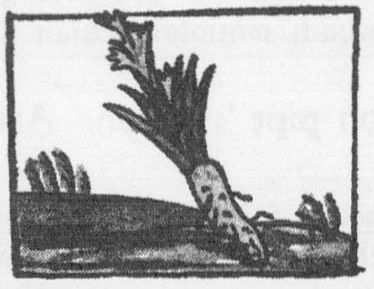
Xiuh-amolli, soap plant. Saponaria americana, *p. 11, 1e.
A small plant whose root yields a glutinous lather and supplies an excellent soap. Note the use of xiuh -as prefix, instead of a terminal xihuitl , to mark particularly its smallness and herbaceous character.
Amoxtli, paper plant or rush; also name for paper, book, etc.
We only have this as te-amoxtli , or a papyrus reed growing on stony ground; the illustrations at pp. 7, 29, and that of the small or tepitonte-amoxtli all show the marshy bottom. This marshy base is also seen with the teo-iztaquilitl , *p. 3, or Portulaca oleracea L, growing in red earth, at 5f as growing in a stone-filled marsh. With these also note the marshy base of the xiuh-tlemaitl on p. 85. (See these latter in their places.) The te-amoxtli is prescribed seven times in the text passages, at 5d, 8b, 8f, 9f, 9p, 9q, 12b.
Paper made in ancient Mexico was of two kinds, one from the above papyrus, and the finer kind from the fig-tree, or Ficus petiolaris, illustrated by Hernndez at p. 82 as the tepe-amatl , mountain fig, or texcal-amatl , rock-cavern fig. Specimens of this paper we still have in our few surviving codices, and it further gave its name to the sacred calendar-book the Tonalamatl .
Font size:
Interval:
Bookmark:
Similar books «An Aztec Herbal: The Classic Codex of 1552»
Look at similar books to An Aztec Herbal: The Classic Codex of 1552. We have selected literature similar in name and meaning in the hope of providing readers with more options to find new, interesting, not yet read works.
Discussion, reviews of the book An Aztec Herbal: The Classic Codex of 1552 and just readers' own opinions. Leave your comments, write what you think about the work, its meaning or the main characters. Specify what exactly you liked and what you didn't like, and why you think so.

